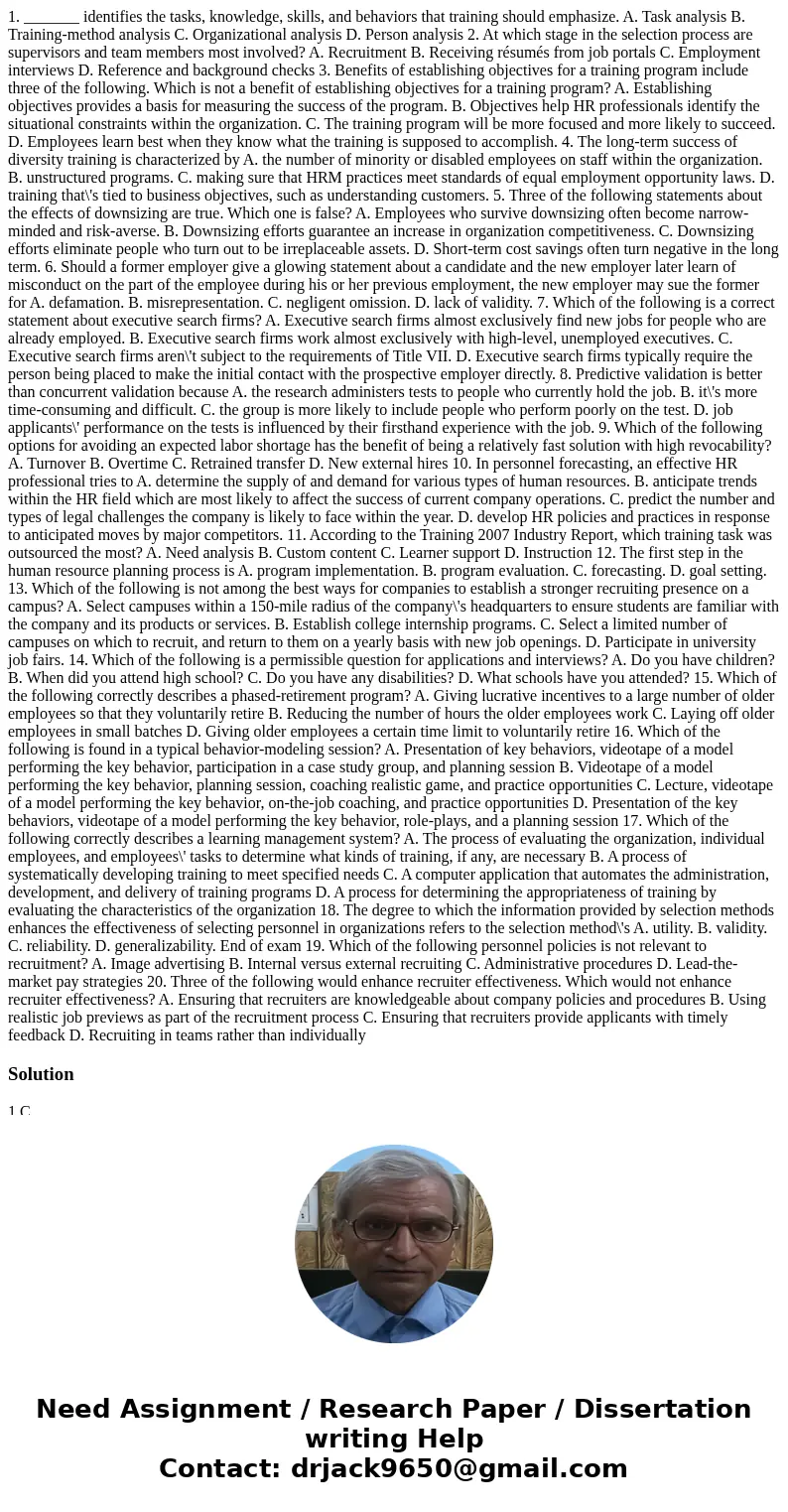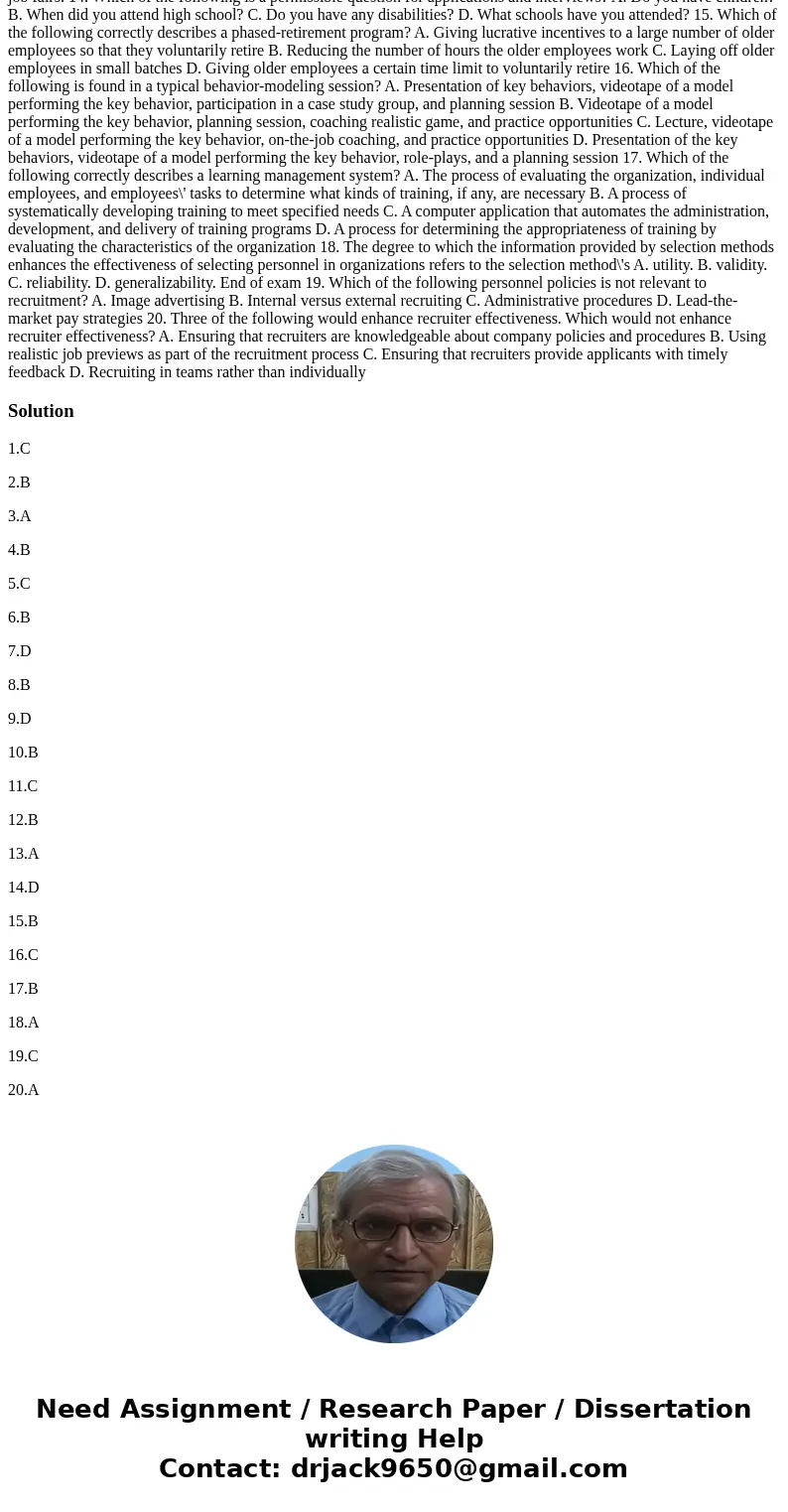1 identifies the tasks knowledge skills and behaviors that
1. _______ identifies the tasks, knowledge, skills, and behaviors that training should emphasize. A. Task analysis B. Training-method analysis C. Organizational analysis D. Person analysis 2. At which stage in the selection process are supervisors and team members most involved? A. Recruitment B. Receiving résumés from job portals C. Employment interviews D. Reference and background checks 3. Benefits of establishing objectives for a training program include three of the following. Which is not a benefit of establishing objectives for a training program? A. Establishing objectives provides a basis for measuring the success of the program. B. Objectives help HR professionals identify the situational constraints within the organization. C. The training program will be more focused and more likely to succeed. D. Employees learn best when they know what the training is supposed to accomplish. 4. The long-term success of diversity training is characterized by A. the number of minority or disabled employees on staff within the organization. B. unstructured programs. C. making sure that HRM practices meet standards of equal employment opportunity laws. D. training that\'s tied to business objectives, such as understanding customers. 5. Three of the following statements about the effects of downsizing are true. Which one is false? A. Employees who survive downsizing often become narrow-minded and risk-averse. B. Downsizing efforts guarantee an increase in organization competitiveness. C. Downsizing efforts eliminate people who turn out to be irreplaceable assets. D. Short-term cost savings often turn negative in the long term. 6. Should a former employer give a glowing statement about a candidate and the new employer later learn of misconduct on the part of the employee during his or her previous employment, the new employer may sue the former for A. defamation. B. misrepresentation. C. negligent omission. D. lack of validity. 7. Which of the following is a correct statement about executive search firms? A. Executive search firms almost exclusively find new jobs for people who are already employed. B. Executive search firms work almost exclusively with high-level, unemployed executives. C. Executive search firms aren\'t subject to the requirements of Title VII. D. Executive search firms typically require the person being placed to make the initial contact with the prospective employer directly. 8. Predictive validation is better than concurrent validation because A. the research administers tests to people who currently hold the job. B. it\'s more time-consuming and difficult. C. the group is more likely to include people who perform poorly on the test. D. job applicants\' performance on the tests is influenced by their firsthand experience with the job. 9. Which of the following options for avoiding an expected labor shortage has the benefit of being a relatively fast solution with high revocability? A. Turnover B. Overtime C. Retrained transfer D. New external hires 10. In personnel forecasting, an effective HR professional tries to A. determine the supply of and demand for various types of human resources. B. anticipate trends within the HR field which are most likely to affect the success of current company operations. C. predict the number and types of legal challenges the company is likely to face within the year. D. develop HR policies and practices in response to anticipated moves by major competitors. 11. According to the Training 2007 Industry Report, which training task was outsourced the most? A. Need analysis B. Custom content C. Learner support D. Instruction 12. The first step in the human resource planning process is A. program implementation. B. program evaluation. C. forecasting. D. goal setting. 13. Which of the following is not among the best ways for companies to establish a stronger recruiting presence on a campus? A. Select campuses within a 150-mile radius of the company\'s headquarters to ensure students are familiar with the company and its products or services. B. Establish college internship programs. C. Select a limited number of campuses on which to recruit, and return to them on a yearly basis with new job openings. D. Participate in university job fairs. 14. Which of the following is a permissible question for applications and interviews? A. Do you have children? B. When did you attend high school? C. Do you have any disabilities? D. What schools have you attended? 15. Which of the following correctly describes a phased-retirement program? A. Giving lucrative incentives to a large number of older employees so that they voluntarily retire B. Reducing the number of hours the older employees work C. Laying off older employees in small batches D. Giving older employees a certain time limit to voluntarily retire 16. Which of the following is found in a typical behavior-modeling session? A. Presentation of key behaviors, videotape of a model performing the key behavior, participation in a case study group, and planning session B. Videotape of a model performing the key behavior, planning session, coaching realistic game, and practice opportunities C. Lecture, videotape of a model performing the key behavior, on-the-job coaching, and practice opportunities D. Presentation of the key behaviors, videotape of a model performing the key behavior, role-plays, and a planning session 17. Which of the following correctly describes a learning management system? A. The process of evaluating the organization, individual employees, and employees\' tasks to determine what kinds of training, if any, are necessary B. A process of systematically developing training to meet specified needs C. A computer application that automates the administration, development, and delivery of training programs D. A process for determining the appropriateness of training by evaluating the characteristics of the organization 18. The degree to which the information provided by selection methods enhances the effectiveness of selecting personnel in organizations refers to the selection method\'s A. utility. B. validity. C. reliability. D. generalizability. End of exam 19. Which of the following personnel policies is not relevant to recruitment? A. Image advertising B. Internal versus external recruiting C. Administrative procedures D. Lead-the-market pay strategies 20. Three of the following would enhance recruiter effectiveness. Which would not enhance recruiter effectiveness? A. Ensuring that recruiters are knowledgeable about company policies and procedures B. Using realistic job previews as part of the recruitment process C. Ensuring that recruiters provide applicants with timely feedback D. Recruiting in teams rather than individually
Solution
1.C
2.B
3.A
4.B
5.C
6.B
7.D
8.B
9.D
10.B
11.C
12.B
13.A
14.D
15.B
16.C
17.B
18.A
19.C
20.A


 Homework Sourse
Homework Sourse